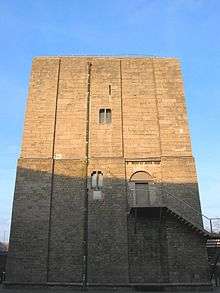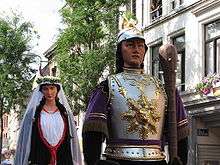Ath
Ath (French pronunciation: [at]; Dutch: Aat, Picard: Ât, Walloon: Ate) is a Belgian municipality located in the Walloon province of Hainaut. The Ath municipality includes the old communes of Lanquesaint, Irchonwelz, Ormeignies, Bouvignies, Ostiches, Rebaix, Maffle, Arbre, Houtaing, Ligne, Mainvault, Moulbaix, Villers-Notre-Dame, Villers-Saint-Amand, Ghislenghien (Dutch: Gellingen), Isières, Meslin-l'Evêque, and Gibecq.
Ath | |
|---|---|
Ath City Hall | |
 Flag Coat of arms | |
 Ath Location in Belgium
Location of Ath in Hainaut  | |
| Coordinates: 50°37′N 03°46′E | |
| Country | Belgium |
| Community | French Community |
| Region | Wallonia |
| Province | Hainaut |
| Arrondissement | Ath |
| Government | |
| • Mayor | Bruno Lefèbvre (PS) |
| • Governing party/ies | PS-MR-Ecolo |
| Area | |
| • Total | 126.95 km2 (49.02 sq mi) |
| Population (2018-01-01)[1] | |
| • Total | 29,164 |
| • Density | 230/km2 (590/sq mi) |
| Postal codes | 7800, 7801, 7802, 7803, 7804, 7810, 7811, 7812, 7822, 7823 |
| Area codes | 068 |
| Website | www.ath.be |



Ath is known as the "City of Giants" after the Ducasse d'Ath festivities which take place every year on the fourth weekend in August. Huge figures representing Goliath, Samson, and other allegoric figures are paraded through the streets, and Goliath's wedding and his famous fight with David are re-enacted.
History
Pre–1500
Archeological records show the existence of several Gallo-Roman settlements in the Ath area. The origin of the city of Ath, however, dates from around 1160, when Count Baudouin IV of Hainaut, bought some territory from his liegeman, Gilles de Trazegnies. A few years later, Baldwin built the Burbant Tower – which can still be seen today – to protect his new acquisition. The new city was soon given privileges and its newly built (1325) market hall on the Grand-Place began to attract residents.
Ath was the setting of the "Peace of Ath", signed on June 4, 1357, to end the question of the Brabant succession.[2] By then, the weekly Ath market, which took place – and still takes place – on Thursdays, had started attracting sellers from a much larger region. The production of linen, cloth, hide, and luxury items such as gold ware, cabinets, and sculptures was growing fast. The population growth necessitated the building of a second wall, which was completed at the end of the 14th century. In 1416, the city built a school for the study of Latin, which Justus Lipsius attended. The city counted then about 5,000 people.
1501–present
In 1667, Ath was conquered in a single day by the army of Louis XIV and became the first French city of the Spanish Netherlands. Soon after, Vauban built new fortifications, which included eight bastions. The city suffered again at the hands of the French army in 1745. At the end of the 18th century, Ath counted about 7,300 inhabitants but the population count decreased in the first half of the 19th century.
In 1816, two military engineering surveys concluded that Ath defences should be improved, the British survey recommended a garrison of 3,000 troops and the building cost would be £143,599. The Dutch wished to spend an additional £266,000. The Duke of Wellington agreed to the Dutch plan. The funding was paid for by England (30%), Holland (30%) and by French war reparations (40%).[3]:388 In 1824, the Dutch under King William I, built the Féron Fort, and the city once more gained strategic value.
A treaty drafted in London on 15 November 1831,[4] which the Netherlands refused to sign, was followed by the Treaty of London (1839), which created the Kingdom of Belgium. Part of the terms of the treaty required the fort, amongst others, to be dismantled.
The freed up land assisted the town for the activities of a growing population. A new growth period took place between 1850 and 1914 driven by the forestry, agricultural (breweries, mills) and textile industries.
In the 20th century, most of these industries went into decline and were replaced by commercial, administrative and educational activities. In the last 30 years, several neighbourhoods have been revitalized and developed, and the city's monuments renovated or restored.
July 30, 2004 explosions
The Ghislenghien industrial park near Ath was the scene of one of Belgium's worst ever industrial disasters on July 30, 2004. Around 8:30 am local time, workers constructing a new factory for abrasives firm Diamant Boart (a subsidiary of the Electrolux Group)[5][6] reported a strong smell of gas. It is believed the gas was escaping from a high-pressure underground pipeline conveying natural gas from Zeebrugge to France, operated by gas transportation company Fluxys. Firefighters were soon on the scene and were attempting to clear the area when at least two explosions occurred at around 9:00 am. The strongest of these demolished the partly built Diamant Boart structure, and fires were started in several other buildings. The official death-toll has risen to 23, with over 120 injured. Five volunteer firemen and one police officer were among the dead.
The cause of the leak has not yet been ascertained. After the explosion, signs of damage by a construction machine were discovered on the exploded part of the pipeline and the adjacent parts. Probably these were the result of construction works a few weeks before the explosion. The pipeline probably ruptured completely on July 30, 2004, when operator Fluxys raised the pressure.
Sights
- The 12th-century Burbant tower was built by Baudouin IV and named after the neighbouring Landgraviate of Brabant.
- The town hall dates from the 17th century.
- The church of Saint Julien, rebuilt after a fire in the 19th century, still keeps a Gothic tower and apsidal chapel, as well as a famous 16th-century carillon.
- The church of Saint Martin and the exterior oak calvary both date from the 16th century.
Festivities
- The “Ducasse”[7] originated from a yearly procession developed in the 15th century (first mentioned in 1399) as a celebration of the consecration of the local Saint Julien church. This procession illustrated stories from the Old Testament, New Testament, Golden Legend, and Carolingian cycle. Today, the “Ducasse” is a very popular celebration that includes various festivities and lasts several days spanning the end of August and beginning of September. The highlight is the cortege of giants[8] (in French: Cortège des géants), with David and Goliath as the most famous characters. The ducasse is listed among the Masterpieces of the Oral and Intangible Heritage of Humanity.
Transportation
Ath is located along the N56 road.
People born in Ath
- Arnold Caussin, born about 1510. Musician, composer. Student in the University of Cracow in 1526.[9]
- Michael Baius, theologian
- Julien-Joseph Ducorron, painter (1770–1848)
- Eugène Defacqz, politician (1797–1871)
- Jean Taisner, priest and scientist (16th century)
- Louis Hennepin, Catholic priest and missionary, and explorer of the interior of North America (17th century).[10]
- Fanny Heldy, opera soprano (19th century)
- Joseph Jules Descamps, politician (1820–1892).
- Ernest F. Cambier, Belgian colonial pioneer (1844–1921)
- Henri Vernes, novelist (20th century)
- Guy Spitaels, politician (20th century)
- Olivier Dupuis, politician (20th century)
- Pierre Descamps, politician (20th century)
- Anders Tang, humorist (20th century)
- Julian the Hospitaller, legendary saint, was according to one tradition born in Ath
- Jacques de Saint-Luc, lutenist and composer (1616 – c. 1710)
References
- "Wettelijke Bevolking per gemeente op 1 januari 2018". Statbel. Retrieved 9 March 2019.
- Sickling, LHJ. Neptune and the Netherlands: State, Economy, and War at Sea in the Renaissance. p. 22.
- Porter, Maj Gen Whitworth (1889). History of the Corps of Royal Engineers Vol I. Chatham: The Institution of Royal Engineers.
- "State Papers".
- "Diamant Boart". www.diamant-boart.com. Retrieved 18 April 2018.
- http://www.electrolux.com/node684.asp
- Meurand, R. (1981). La Ducace d’Ath (in French). cited in fr:Ducasse d'Ath. Ath.
- Meurand, R. (1979). Géants processionnels et de cortège en Europe, en Belgique, en Wallonie (in French). cited in fr:Ducasse d'Ath. Tielt.
- Henri Musielak, Revue de Musicologie, t. 62, n° 2, [Paris] 1976, p. 308.
- Who Was Who in America, Historical Volume, 1607–1896. Chicago: Marquis Who's Who. 1963.
External links
| Wikimedia Commons has media related to Ath. |
- Cercle Royal d'Histoire et d'Archéologie d'Ath et de la Région et Musées Athois, an exhaustive list of references on the history of the Ath region, in French.
- Official site of the city, in French, Dutch, and English.
- The Ducasse of Ath, in French.
- Awarded "EDEN - European Destinations of Excellence" non traditional tourist destination 2008
